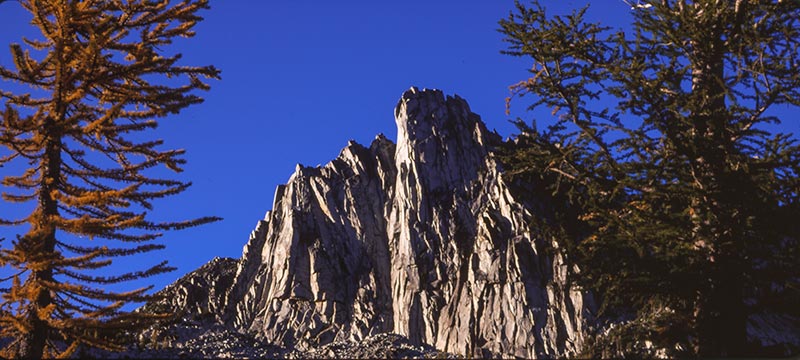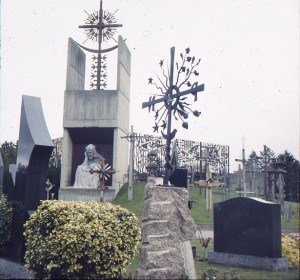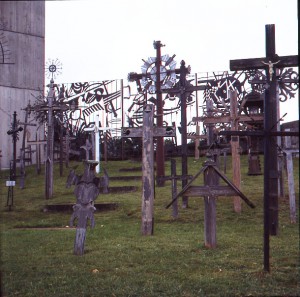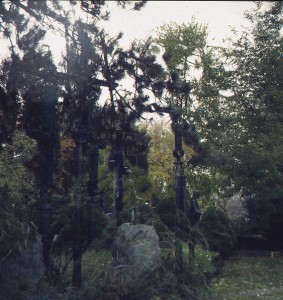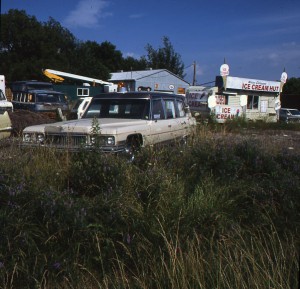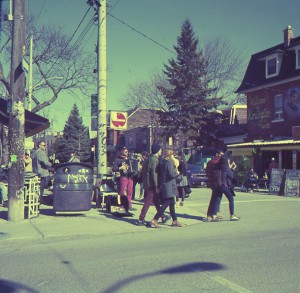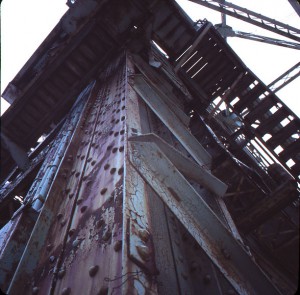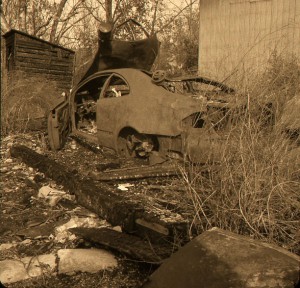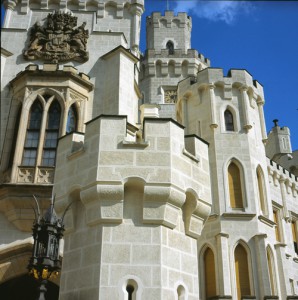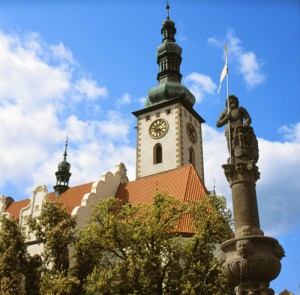Category Archives: FolioA
Concepcion Mission Church
Concepcion (1731)
One 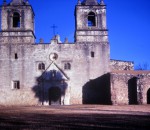 of the most attractive of the San Antonio missions, the church at Concepcion looks essentially as it did more than 200 years ago, when it stood at the center of local religious activity. The mission was well known for its religious celebrations. Not visible today are the colorful geometric designs that originally covered the exterior surface of the mission. Inside, however, are original paintings of religious symbols and architectural designs. These outposts were established by Catholic religious orders to spread Christianity among the local natives. These missions formed part of a colonization system that stretched across the Spanish Southwest in the 17th, 18th, and 19th centuries. This is one of the 5 San Antonio missions, the Alamo is owned by the state of Texas and operated by the Daughters of the Revolution. The National Historical Park encompasses 4 of the missions. Taken with the TL 120.
of the most attractive of the San Antonio missions, the church at Concepcion looks essentially as it did more than 200 years ago, when it stood at the center of local religious activity. The mission was well known for its religious celebrations. Not visible today are the colorful geometric designs that originally covered the exterior surface of the mission. Inside, however, are original paintings of religious symbols and architectural designs. These outposts were established by Catholic religious orders to spread Christianity among the local natives. These missions formed part of a colonization system that stretched across the Spanish Southwest in the 17th, 18th, and 19th centuries. This is one of the 5 San Antonio missions, the Alamo is owned by the state of Texas and operated by the Daughters of the Revolution. The National Historical Park encompasses 4 of the missions. Taken with the TL 120.
Mazamitla, Mexico
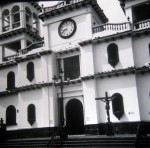 Mazamitla is located in the south-central area of Jalisco, south of Lake Chapala. Mazamitla is in the pine woods, more than 7000 feet up, clean air, cooler temperatures, a beautiful setting. San Cristobal Parish Church is an architectural wonder, blessed, for some reason, with an exterior that stirs thoughts of a Chinese pagoda. As usual, it appears freshly painted, white trimmed in red. There were flowers at the entrance. History says the clock in the tower has trouble keeping time. This image was taken with the spud Tech Pan film reversal process. How I miss Mexico!!!
Mazamitla is located in the south-central area of Jalisco, south of Lake Chapala. Mazamitla is in the pine woods, more than 7000 feet up, clean air, cooler temperatures, a beautiful setting. San Cristobal Parish Church is an architectural wonder, blessed, for some reason, with an exterior that stirs thoughts of a Chinese pagoda. As usual, it appears freshly painted, white trimmed in red. There were flowers at the entrance. History says the clock in the tower has trouble keeping time. This image was taken with the spud Tech Pan film reversal process. How I miss Mexico!!!
Prada Marfa
The brainchild of Berlin-based artistic team Elmgreen and Dragset, Prada Marfa was meant to be a “pop architectural land art project.” Built of a biodegradable adobe-like substance, the building is meant to slowly melt back into the Earth, serving as a surrealist commentary on Western materialism. Prada Marfa is located northwest of Valentine, Texas, just off U.S. Route 90, and about 60 km northwest of the city of Marfa. Costing a sum total of $80,000 – or, put another way, about 40 Prada handbags
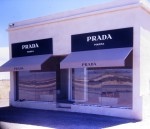 Due to vandalism the handbags have no bottoms and all of the shoes are right-footed. While the vandalism might be the most exciting thing that’s ever happened to Prada Marfa, the site still gets thousands of visitors a year, despite Route 90’s low traffic flow Most people buy the artists’ story, but a few vocal dissenters have flooded the internet with conspiracy theories. Some even argue that Prada Marfa is a trap set by aliens meant to attract potential abductees. Visitors beware.
Due to vandalism the handbags have no bottoms and all of the shoes are right-footed. While the vandalism might be the most exciting thing that’s ever happened to Prada Marfa, the site still gets thousands of visitors a year, despite Route 90’s low traffic flow Most people buy the artists’ story, but a few vocal dissenters have flooded the internet with conspiracy theories. Some even argue that Prada Marfa is a trap set by aliens meant to attract potential abductees. Visitors beware.
In March of 2014, the Prada in Marfa was vandalized with blue paint and graffiti. Image was taken with the TL 120.
Tajin
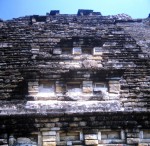 Located in the state of Veracruz, El Tajin was at its height from the early 9th to the early 13th century. It became the most important centre in north-east Mesoamerica after the fall of the Teotihuacan Empire. Its cultural influence extended all along the Gulf and penetrated into the Maya region and the high plateaux of central Mexico. Its architecture, which is unique in Mesoamerica, is characterized by elaborate carved reliefs on the columns and frieze. The ‘Pyramid of the Niches’, a masterpiece of ancient Mexican and American architecture, reveals the astronomical and symbolic significance of the buildings. El Tajin has survived as an outstanding example of the grandeur and importance of the pre-Hispanic cultures of Mexico. Taken with the spud, hand held.
Located in the state of Veracruz, El Tajin was at its height from the early 9th to the early 13th century. It became the most important centre in north-east Mesoamerica after the fall of the Teotihuacan Empire. Its cultural influence extended all along the Gulf and penetrated into the Maya region and the high plateaux of central Mexico. Its architecture, which is unique in Mesoamerica, is characterized by elaborate carved reliefs on the columns and frieze. The ‘Pyramid of the Niches’, a masterpiece of ancient Mexican and American architecture, reveals the astronomical and symbolic significance of the buildings. El Tajin has survived as an outstanding example of the grandeur and importance of the pre-Hispanic cultures of Mexico. Taken with the spud, hand held.
Spiny Cross Plus
Shot at St. John’s Lithuanian Cemetery in Mississauga, Ontario, Canada, a suburb of Toronto. This was shot with what sunlight was present just over my left shoulder. The weather certainly added a certain visual “mood” to the shot.
Sea of Crosses
Shot at St. John’s Lithuanian Cemetery in Mississauga, Ontario, Canada, a suburb of Toronto. The hill was filled with crosses of a variety of materials and ages, on a hill always rising away from you. The weather certainly added a certain visual “mood” to the shot.
Christ in the Trees
Shot at St. John’s Lithuanian Cemetery in Mississauga, Ontario, Canada, a suburb of Toronto. This is a double exposure taken on an overcast, rainy day. The weather certainly added a certain visual “mood” to the shot.
Death By Ice Cream
Kensington
I had just obtained a number of old Kodak Series V filters, so I decided to do some experimenting. I took my Rolleidoscop loaded with Fuji NPH400 to Kensington Market in Toronto and spent the day using the various filters. This was shot with a pair of Y1 filters. I had the NPH400 cross-processed in E6 chemistry by Toronto Image Works (who sadly just discontinued their E6 processing for good).
Riveted
My friend Rick was shooting a bridge near Cherry Street in Toronto and invited me down. Apparently a road crew was about to refurbish the bridge, so we thought we better capture the peeling paint while we had a chance. Shot with TL-120 modified with Sam Smith’s 55mm conversion Mamiya lenses on Fuji film.
Final Rusting Place
Approximately once a year dr5 offers “Dev2” service, which is basically sepia processing. The only Fuji film that can be processed in dr5 is Neopan 400, and at that only in Dev2. When dr5 announced the limited availability of Dev2 last year, I grabbed the only roll of Neopan 400 I had, and drove out to the airport. Behind a strip mall row, beside a dilapidated parts factory, resided a trio of desecrated automobile shells. This was part of that day’s one roll shoot. Shot with a TL-120 modified with Sam Smith’s 55mm conversion, on the aforementioned film using a handheld meter.
Hluboka Fairytale Palace
Tabor Square
Charles Bridge, Prague
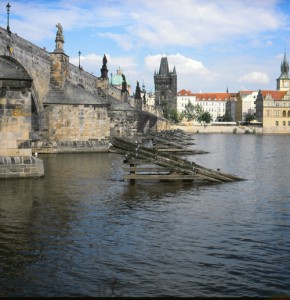 If you go to Prague, you will inevitably find the fine stone bridge built by King Charles I. It is one of the oldest stone bridges in Europe and is a very popular attraction in the heart of the medieval town. This image was shot with my TL120 camera on Provia 100f film. Maybe on the next round I will have a similar, only hyper shot from my Lubitel hyper rig. I still have to take the film in for processing.
If you go to Prague, you will inevitably find the fine stone bridge built by King Charles I. It is one of the oldest stone bridges in Europe and is a very popular attraction in the heart of the medieval town. This image was shot with my TL120 camera on Provia 100f film. Maybe on the next round I will have a similar, only hyper shot from my Lubitel hyper rig. I still have to take the film in for processing.
